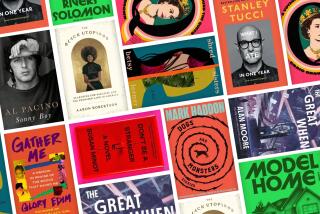DISCOVERIES
Love Letters From a Fat Man
Naomi Benaron
BkMk Press: 234 pp., $16.95 paper
THE nervous, tender-hearted stories in “Love Letters From a Fat Man” are often set in that netherworld humans inhabit after loss -- that strange, weightless, one-foot-in-front-of-the-other place that is a buffer between the painful present and the next chapter. Naomi Benaron’s characters find safety in the oddest ways, like Otto in the title story, who watches Marlene Dietrich movies. In “Vibrations of a Desert Rose,” Sylvia thinks “about vibrational nodes, those places along the surface of a standing wave where motion ceases,” realizing that the shoulder she’s leaning on is just such a place. Ingabire, a dancer, finds herself in a Rwandan refugee camp with a burning fever. She dreams of dancing, “the earth grows dark with blood. The cries of her people rise through the soles of her feet.” The stories in this debut collection never relax, never loosen their grip, never stop their painful, sparkling insistence that there is something finer, safer, kinder somewhere.
--
The Meaning of Sunglasses
And a Guide to Almost All Things Fashionable
Hadley Freeman
Viking: 238 pp., $24.95
“YOU have to wonder how precarious a woman’s self-image must be to be damaged by showing an interest in fashion, and it is on this kind of knife edge, poised between careful cerebralism and mocking artificiality, that Prada balances,” says Hadley Freeman, deputy fashion editor at the Guardian and contributing editor for British Vogue. It’s not just a matter of precarious self-image that keeps people from having fun with fashion; it’s the idea that fashion is for the shallow rich whose self-image is so precarious that they allow it to be plumped up by marketing nerds out to make more money than they deserve. Freeman takes it with a grain of salt. She rejoices in the fact that women aren’t stupid; they make choices (a $1,400 bag, unlike a $1,400 dress, will never make you look fat) and realize that more and more inexpensive but just as fabulous knockoffs are becoming available every day. This does not for a second mean that Freeman doesn’t insist on some hard and fast rules: No animal prints. (“Yeah, we get it, babe -- you’re wild. In the sack, yes, yes. Like on Discovery Channel -- WE GOT IT.”) Or cleavage. (“There’s nothing wrong with a woman embracing her sexual power, but when she hikes it up under everyone’s nose with the desperation of a drunken aunt seizing the bar mitzvah mic for a quick impersonation of Chaka Khan, protests must be made.”)
--
The Perfect Scent
A Year Inside the Perfume Industry
in Paris and New York
Chandler Burr
Henry Holt: 306 pp., $25
“The Perfect Scent” has drama, unforgettable characters, history and location. Chandler Burr, scent critic for the New York Times, shows how Hermes, the French saddle maker, and Coty, the $3-billion perfume conglomerate, poured their considerable resources and very different talents into creating scents that they hoped would unseat “le monstre,” Chanel No. 5 -- the bestselling perfume in the world for nearly 90 years. Coty’s ace in the hole was celebrity Sarah Jessica Parker, who threw herself into the creation of the fragrance Lovely. Hermes had master French perfumer Jean-Claude Ellena, one of the many-generation “mafia grassoise” of Grasse, the scent capital of the world, who created Un Jardin Sur Nile. The details of the craft are truly fascinating: the “heartbreakingly evanescent” smell of green mango, the landscape of Grasse and the knowledge that is passed between family members and friends.
--


